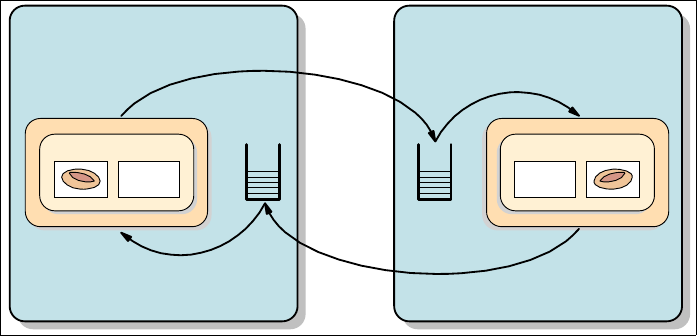Chapter 6. Technology options 133
Outbound adapters
Outbound adapters are used by application initiated requests to an EIS.
Inbound adapters
Inbound adapters are used by the EIS making calls to a message-driven
bean.
The J2EE Connector Architecture provides a Common Client Interface API (CCI)
with both common, and resource adapter specific, interfaces. Application
programmers code to this single API rather than needing to use different
interfaces for each proprietary system. However it is common for a resource
adapter to make use of its own, or an existing API, such as JDBC or JMS.
The J2EE Connector Architecture specification provides support for transactions,
security and sharing of connections between different clients.
Advantages of the J2EE Connector Architecture
Some reasons to use J2EE Connector Architecture resource adapters are:
The CCI simplifies application integration with diverse EISs. This common
interface makes it easy to plug third-party or home-grown resource adapters
into your applications.
Inbound adapters provide a way to get a message-driven bean invoked when
an event occurs in the EIS. For example, a message arrives at a JMS
destination.
Outbound adapters that are XA capable automatically participate in any
transactions in effect without requiring action by an application.
Outbound adapters can pick up security credentials from the container in
which they execute.
Connections to the EIS can be shared to reduce resource overhead.
Disadvantages of the J2EE Connector Architecture
Although the CCI provides a common interface definition, some resource adapter
specific interfaces still need to be used and the usage of these interfaces varies
depending on the EIS the resource adapter used.
6.4.3 Java Message Service
Messaging middleware is a popular choice for accessing existing enterprise
systems in an asynchronous manner. It is one of the options if you are
implementing a solution based on the Directly Integrated Single Channel
application pattern.

134 Patterns: Implementing Self-Service in an SOA Environment
A standard way for using messaging middleware from a Java application is using
the Java Message Service (JMS) interface. JMS offers Java programmers a
common way to create, send, receive and read enterprise messages. The JMS
specification was developed by Sun Microsystems with the active involvement of
IBM, other enterprise messaging vendors, transaction processing vendors, and
RDBMS vendors.
In IBM WebSphere Application Server V6.0, the J2EE 1.4 specification is
implemented, which includes JMS 1.1 and EJB 2.1.
According to the JMS 1.1 specification, a message provider is integrated in an
application server. As shown in Figure 6-5, the integrated message provider
makes it possible to communicate asynchronously with other WebSphere
applications, without installing separate messaging software such as IBM
WebSphere MQ. WebSphere’s integrated JMS server is based on IBM
WebSphere MQ.
Figure 6-5 Integrated JMS provider
An important feature of EJB 2.1 is message-driven beans (MDB). As described in
6.3.9, “Enterprise JavaBeans” on page 124, message-driven beans are designed
specifically to handle incoming JMS messages.
What is messaging?
Messaging is a form of communication between two or more software
applications or components. One strength of messaging is application
integration. Messaging communication is
loosely coupled, as compared to tightly
coupled technologies such as Remote Method Invocation (RMI) or Remote
Procedure Calls (RPC). The sender does not need to know anything about the
J2EE ServerJ2EE Server
Message
PUT
Message
GET
J2EE Application
Web
Message
GET
Message
PUT
J2EE Application
Web
Get Patterns: Implementing Self-Service in an SOA Environment now with the O’Reilly learning platform.
O’Reilly members experience books, live events, courses curated by job role, and more from O’Reilly and nearly 200 top publishers.

